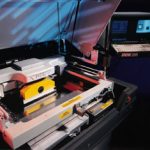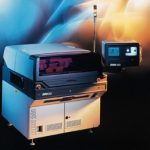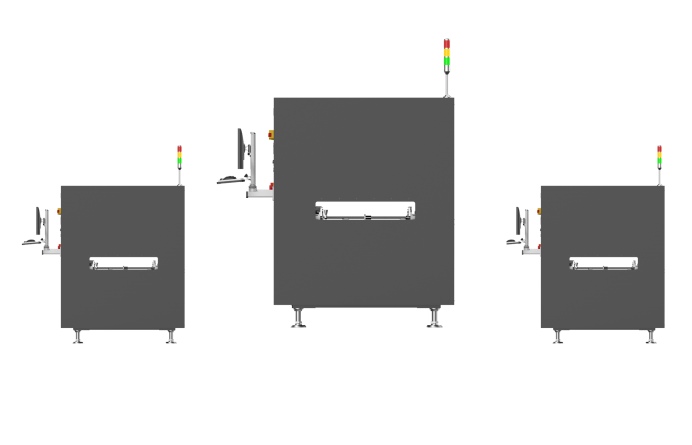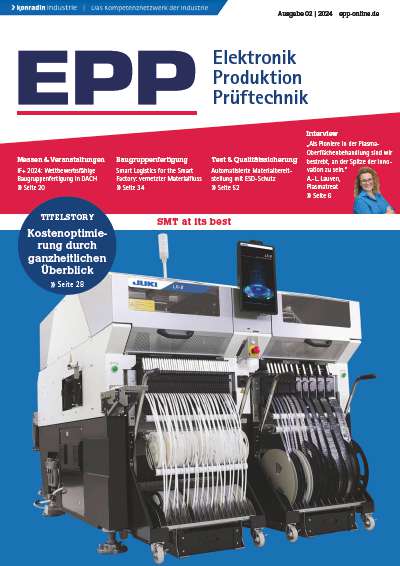For two years, Irish telecom manufacturer, Tellabs, had been assembling double-sided PCBs using the ProFlow imaging print system from DEK to place solder paste, and the Loctite Varidot system for adhesive deposition. But when a joint development brought the two technologies together, the advantages escalated.
Charles Green for DEK, Weymouth
Tellabs in Shannon, Ireland, is the European subsidiary of the U.S. parent company, and specializes in making a wide range of high-end professional network devices for telecommunications service providers. The company has recently entered the consumer telecoms market with home electronics to provide cable TV users with an additional phone, Internet and fax line. This product will allow cable operators to increase their offering to customers and compete globally with established telcos and ISPs (internet service provider).
As such the device calls for high-volume production, so Tellabs is currently running a two-shift operation, 24-hours per day. Around 1200 PCB assemblies are produced per day, destined for the European market. „We began using ProFlow shortly after DEK introduced it in 1997, and were pleased with the performance it offered for paste deposition,“ says Tellabs process engineer, Michael Culhane. „When the opportunity arose to extend the benefits of ProFlow – less waste, faster deposition, easier materials handling – to our adhesive deposition processes, we were keen to see the results.“
Trial and no error
After a group of Tellabs engineers saw a ProFlow-enabled DEK265 printer apply adhesive using the Varidot system at Nepcon Ireland last year, they became extremely keen to try the process themselves. „After an initial trial, we were so impressed that we now intend to use the ProFlow/Varidot combination to print adhesive on both our high volume lines. We have achieved new levels of consistency in dot deposition, alongside huge savings in adhesive consumption. The process is also exceptionally clean,“ says Culhane. The assembly is double sided with a mix of SMT (surface mount technology) and THT (through-hole technology) components. Underside adhesive deposition has been carried with a standard DEK 265 printer, using high-speed adhesive (type-3616) and Varidot stencils from Loctite.
Tellabs Shannon operates two identical high-volume assembly lines for production of the consumer-oriented boards. The lines are capable of single and double-side assembly of both surface-mount and mixed-technology boards. Each is equipped with two DEK265 printers, one to print adhesive for locating bottom-side surface mount components, and the other to apply solder paste on top-side assembly. Although at present only one of the adhesive printers is fitted with ProFlow, Tellabs has planned to retrofit a ProFlow head to its second adhesive printer. „Now we have a ProFlow-equipped printer in each line, we have much greater flexibility,“ says the advanced manufacturing engineer, Vincent McHugo. „For very high volume production of single sided boards, we can easily reconfigure the first DEK265 in each line to print paste, and then move directly to top-side component placement.“
For the double-sided mixed technology boards, however, the DEK printers are used to apply adhesive. „We first print adhesive on the bottom side to hold a wide range of components in place. These include a large number of small 0603-chips, up to 1206s and 2mm pitch LEDs. Then the adhesive is cured in a reflow oven at 125°C for around 3 to 4 minutes before a sample manual inspection is made. The boards are then stored in a buffer to guard against down or slack-time before being flipped over for top-side assembly.“ A DEK265 with ProFlow is then used to print paste for the top-side assembly on both lines. The boards are populated by chipshooter and flexible placement machine arrangement, the latter being used to place all fine-pitch components. After reflow, a manual visual inspection of a sample quantity follows, and then the boards are stored in a second buffer unit.
„Through-hole insertion is the final assembly stage,“ explains McHugo. „Although the more difficult THT components are currently inserted by hand, we are about to install an odd-form placer. Automating this part of the process should eliminate the traditional throughput and uniformity problems associated with manual assembly.“ The boards are then wavesoldered. Following a final post-wave manual inspection, they move on to in-circuit test.
Deposit height is critical
When using adhesives in surface-mount applications, deposit height is critical. Excessive adhesive can compromise the effectiveness of solder joints as the components are reflowed; however the deposit must be tall enough to make adequate contact with the component to secure it to the board. Each assembly usually requires deposits ranging in height from about 150 to over 500 micron. Dispensing is a popular alternative to printing for depositing adhesives. This offers the chance to control the deposit height on an individual basis, although it is a sequential process and relatively slow. The Varidot system comprises of glue and stencil designed to provide consistent and controllable adhesive deposition through printing, which is inherently faster than dispensing.
DEK sees ProFlow as an enabling technology with implications for the deposition of many materials required by manufacturing processes for electronics. Imaging of adhesives is one of the first applications to be investigated and applied. ProFlow offers improved material conditioning and more consistent process control. Combining this with the existing frame of knowledge relating to stencil-based adhesive deposition makes for significant enhancements.
Quick to benefit
Tellabs has been quick to benefit. „When we first started to print adhesive, the Varidot system, which uses plastic stencils, offered an elegant solution and gave the most consistent results compared to alternatives that used metal stencils,“underlines Culhane. „The other adhesives we assessed tended to clog the stencils easily, and instances of misprinted dots were more frequent. Still, there was room for improvement in consistency and repeatability. That is where ProFlow has made the difference.“
Hugh Fay, senior process chemist at Loctite’s R&D facility in Dublin explains the major concerns for glue deposition, „In the adhesive printing process, the consistency and height of the dots printed through the stencil apertures are vital. The dot height must be sufficient to overcome the height of the solder lands and component leads to reach the underside of each surface mount device. If the dot is too tall, the adhesive can fall over to one side and block the lead-pad connections. If the dot height is insufficient, it may not have enough strength to hold the component in place and can also slump or spread onto the lands to again block the connections.“
Different heights in one stroke
To ensure that these conditions are met, stencil design is critical. Controlling its thickness and aperture diameter allows printing to produce a range of deposit heights in a single pass. The finish of the aperture walls is engineered to ensure optimum adhesion at snap-off. Maintaining optimum process control is also critical to consistently accurate deposition. ProFlow contributes significantly, as Seamus Grant, head of worldwide electronic product development at Loctite, explains. „ProFlow helps ensure that all apertures are completely filled after each print cycle. Combining ProFlow with the Varidot system gives consistently uniform deposits, time after time. The process is predictable and repeatable.“
Perhaps one of the biggest advantages of the process is the fact that the adhesive is contained within an enclosed, air-tight ProFlow cassette. This prevents deterioration of the adhesive caused by exposure to ambient conditions while being rolled across the stencil by a conventional squeegee. Although the Loctite 3616 adhesive has an extended stencil open life, up to one week, the ProFlow cassette dramatically improves the repeatability and quality of the print process and therefore the productivity of the entire line.
Tellabs originally began using ProFlow to improve results from its intrusive reflow process. „We began using ProFlow for pin-in-paste reflow to achieve a wider process window,“ recalls Culhane. „We just couldn’t get a sufficient volume of paste into the apertures with a squeegee, but ProFlow enabled us to print more paste into the board to create better fillets for the THT solder joints.“ In practice, they found that ProFlow brought additional benefits and soon decided to standardize for all its in-house printers.
Materialsand cost savings
„One of the main benefits of a move to ProFlow is the huge savings in materials wastage that can be achieved,“ states McHugo. „Since using ProFlow to print adhesive, we have reduced our materials consumption by 80%. When using a squeegee we had to manually apply a large amount of adhesive to the stencil using a dispense gun to obtain a good print. And to avoid degradation problems we never re-used the wastage. With ProFlow, only a precise amount of adhesive or paste is used, and there is practically zero wastage because it is supplied in a sealed unit. The only wastage we now experience comes from a tiny slither left on stencil after the print cycle which is easily scooped off with a knife.“
This makes the ProFlow-enabled printers much cleaner than their squeegee-based cousins and dramatically reduces the need for regular cleaning. „ProFlow is extremely popular with our operators who keep asking us when we were goingto convert our last remaining squeegee-based DEK265 printer to ProFlow,“ adds Culhane. „It’s also much more user-friendly and controllable in that one head does everything and the printer can be easily reconfigured to apply adhesive or paste; there are no special set-up requirements or squeegee changeover necessary to effect the swap. It is also possible to leave the machine overnight without any materials degradation problems; the first print of the morning shift is always perfect.“ Tellabs‘ users say that there has not been one drawback of using the ProFlow and Varidot combination to print adhesive. „In fact it has worked so well that we have not had to contact either DEK or Loctite since its installation,“ concludes McHugo. „All we basically had to do was put the recommended settings on the machine and let it run. And we haven’t looked back since.“
Fax +44-1305-208-389
EPP 172
Zusammenfassung
DEK hat als Pionier in der Drucktechnik das geschlossene Druckkopfsystem ProFlow perfektioniert, so daß es gleicherweise zum Aufbringen von Lotpaste und Kleber per Schablone geeignet ist. Die großen Vorteile dieses und ähnlicher Systeme: sauberer Druckprozeß, weniger Wartung und Reinigung nötig, exzellente Ergebnisse mit höherer Ausbeute, geringerer Materialbedarf, insgesamt höhere Produktivität sowie geringere Druckkosten.
Résumé
Pionnier de la technique de sérigraphie, DEK a perfectionné le système de tête d’impression fermée ProFlow qui permet d’appliquer aussi bien la pâte que le colle avec un cache. Les gros avantages de ce système et des systèmes comparables sont un processus d’impression propre, un entretien et un nettoyage réduits, l’obtention d’excellents résultats et un rendement élevé, une consommation moindre de produits, une productivité globalement supérieure et des coûts d’impression inférieurs.
Sommario
DEK, nella sua qualità di pioniere nella tecniche distampaggio, ha perfezionato il sistema di testa di stampaggio chiusa ProFlow in maniera tale che esso sia ugualmente idoneo per il riporto di pasta per saldatura a dolce e di collante per maschere. I grandi vantaggi di questo così come di altri sistemi sono un processo di stampaggio pulito, un minor bisogno di manutenzione e di pulizia, degli eccellenti risultati con maggiori rendimenti, una minore necessità di materiale, una produttività nel suo complesso maggiore dei costi di stampaggio ancora più ridotti.
Unsere Webinar-Empfehlung
10.10.22 | 10:00 Uhr | Conformal Coating ist ein wichtiges Verfahren, um elektronische Baugruppen vor dem vorzeitigen Ausfall zu schützen. Damit bekommt der Beschichtungsprozess eine immer höhere Bedeutung. Dabei ist die Auftragsstärke ein wichtiges Qualitätskriterium. Nur eine…
Teilen:












